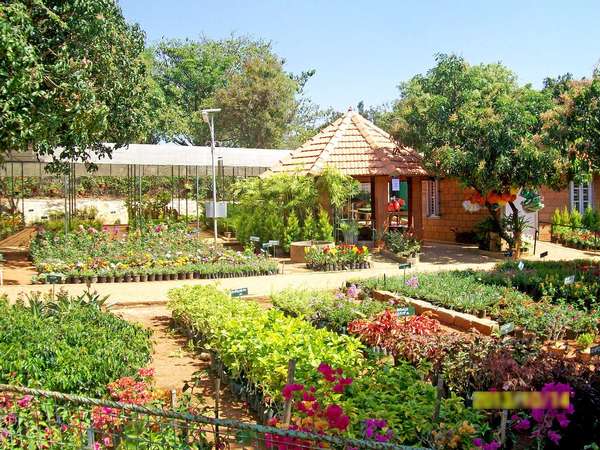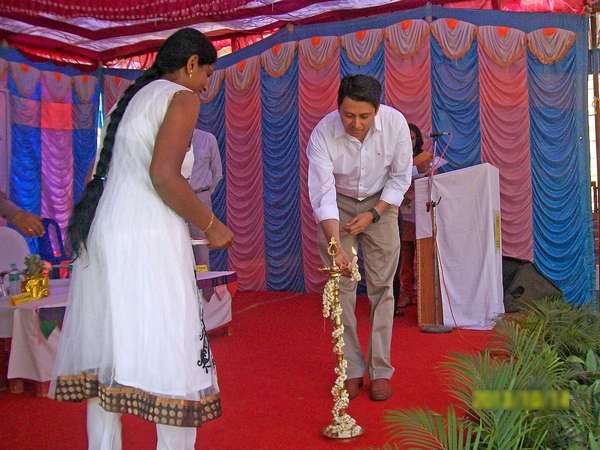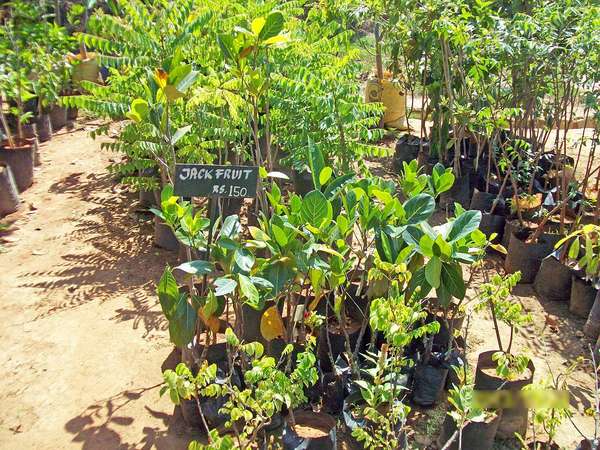"I am amazed to see how this barren land has been transformed into an oasis! " exclaims Prashanth Bhat, a prolific landscaper. He pauses in his speech and gently leans over the podium, to reabsorb the expanse of manicured verdure lying before him. The evidently humbled man takes a breath to proceed, "Such initiatives like this Horticultural Training Centre (HTC) are threatening my own job as a inner-city landscaper," he comments. The gesture is obviously dispensed in tribute to the dazzling dozen-year-old venue.
But the actual occasion Bhat is gracing is the 25-year anniversary celebrations of the HTC. The Centre, as created by the Association for Prevention of Disability (APD), which was the brainchild of N S Hema among others, stands bravely between Hennur Road constructions and tracts of farmland, at Bangalore’s sub-urban Kyanasanahalli.

FOREIGN CORRESPONDENT: British Horticultural Experts and HTC volunteers Sandra Ellis and her colleague John, with friends from the blind school Mitra Jyothi. Pic: Jatin Prabhu
Uncultivated land when it was procured in 2000, today it boasts several acres of sprawling groves, trimmed shrubbery, stocked nurseries and ornate green-houses. Varieties of cacti and palms as well as an explosion of diverse flowers and fruit plants line one’s path, around the water-treatment unit, under bore well-fed tanks and over the stoney reservoir. Large spooky-looking growths, waxy flower-shaped potted-creatures, trellised cascades of delicate blooms, and plants emerging from coconuts add to the diversity, baffling the botanically-illiterate.
But what left me completely agape was the labour force behind all this cultivation – physically handicapped villagers. Put through an intensive 10-month composite course, the trainees are taught every aspect of gardening from potting, to trimming, to soil and water treatment, to general maintenance of a botanical garden. In the process, these diamonds in the rough are turned into polished professionals. Provided with food, stay and basic amenities, they are kept as healthy as possible. But their sense of hard-work and unwavering commitment is abundantly evident.

TINY TOTS: HTC’s diversely-stocked nursery, enticingly catalogued and arranged. Pic: Jatin prabhu
Panelist Bhat shares the dais with three more dignitaries – Sanjay Adhicary of French Insurance firm AXA and two HTC trustees – N S Chinnappa and M J Aravind.
The man who knows HTC’s progressive history only too well, Chinnappa, explains, "We started with one acre of land at Jeevan Bhima Nagar in 1987. It was leased by the BDA (Bangalore Development Authority). We had a handful of trainees then. Till date, we have secured sustainable jobs for 1,500 of our graduates." But then his expression of satisfaction tightens into concern over the journey ahead, "Of the 80 million specially-abled people in India, Karnataka has 15 million. So that means, that we have touched only 1 per cent of the population."
But progress is already underway, according to APD’s Executive Director V S Basavaraju. "Sustained efforts are underway to recruit prospective trainees from villages in and around Devangere, Bijapur and Chikkaballapur," he confirms. We are trying to identify families with differently-abled members and enlighten them about all that our programme offers." He also indicated that in time, the goal would be to set up full-fledged centres farther away from Bangalore.
Help has come from abroad too, in the form of the British horticultural professional Sandra Ellis. This native of Liverpool, England, has made the HTC her home since 2000, passing on her expertise to trainees and equipping them to train others themselves. With help from her colleague John, who makes frequent visits to Bangalore, she has assessed and improved techniques for horticultural training. Even though Sandra is largely hands-on in her methods, she has also conceived of and produced a training manual. But ask her and she humbly downplays her contribution, saying, "I just like my work because it helps me keep in tune with nature."

FLAMING AMONG FLOWERS: Urban landscaper Prashanth Bhat lights the ceremonious lamp to open the HTC festivities. Pic: Jatin Prabhu
Where disability is the issue, perception is the key, opines panelist Adhicary "They say disability is all in the mind. There are so many neurotic people living in cities. Their brains are over-taxed and so they can hardly get anything done. But if you clear your mind, I think anything can be achieved, as HTC has shown."
Almost as though confirming his claim, the next programme in the anniversary celebration saw the facilitation of three blind cricketers. Captain Shekhar Nayak, fresh from Team India’s victory in the Blind Twenty-20 World Cup, led two of his prized team-mates on stage to receive special accolades.
However, it appears the stigma and pity with which disability is viewed in general isn’t changing too quickly. HTC might have a possible solution. "There is no sympathy or charity here," declares a feisty APD board-trustee Jacqueline Colaco. "The trainee’s day begins at 5am. They are all given tasks, including learning life skills such as cleanliness and orderliness. There is no doling to anyone. We are here to enable and empower them." This victim of severe Rheumatoid Arthritis certainly knows what she’s talking about. Nearly two decades of affliction hasn’t stopped the former banker from raising tens of lakhs of rupees for APD. She also raises money by running two marathons annually.
Similarly, all work and no play would make these HTC farm-jacks quite dull. Thus they are encouraged to explore their talent in the arts, as evidence of which many regaled the audience at the celebrations with performances in classical Indian dance and theatrics. The latter was showcased in a riveting skit that used mime to convey a story of builders ruining villagers’ livelihood. Personifications of a tree and a bore-well stood out in the stage ensemble.

JACK THE GIANT: Starting out small, this Jackfruit Tree sapling looks ambitiously skyward. Pic: Jatin Prabhu
But HTC itself would not be sustainable unless a well-fed funding structure remains firmly in place. Keeping the wheels of endowment in motion is Shalini Raj. The young woman who quit a 4-year stint with the Northern Trust Bank, has assumed the APD post of Assistant Manager of Communications and Fundraising.
Passing up of a lucrative career for welfare work may puzzle some, but Shalini has a ready answer. "Earning decent money is important. But when I saw the happy response from people I would help directly, I wanted to switch over to an NGO."
The festivities on stage transitioned into lunch for all at the HTC canteen. Over a nice blend of standard South Indian fare, I got to hob-nob with many of the Centre’s higher-ups. "Are you involved with HTC?", I casually asked an elderly gentleman. "Well, I’m the President of HTC," came the chuckling reply. "I am about to complete 40 years with the HTC. So yes, I guess I am involved!" added the jovial B R Shivshankar.
There is self-effacing humility on the faces of these big men.
As HTC Vice President Chinnappa said, "We make a living by what we get. We make a life by what we give."
My dessert-serving of gulaab-jamun was accompanied by a memento of the occasion. It was a wooden key-chain, embossed with HTC’s momentous year and its logo. As I was leaving, I mused on how Silver Jubilees often refer to marriage anniversaries. Indeed, the Horticultural Training Centre was also celebrating a marriage – a union of the causes of helping the disabled get back on their feet and fighting for a cleaner environment. Happy Anniversary, HTC!⊕